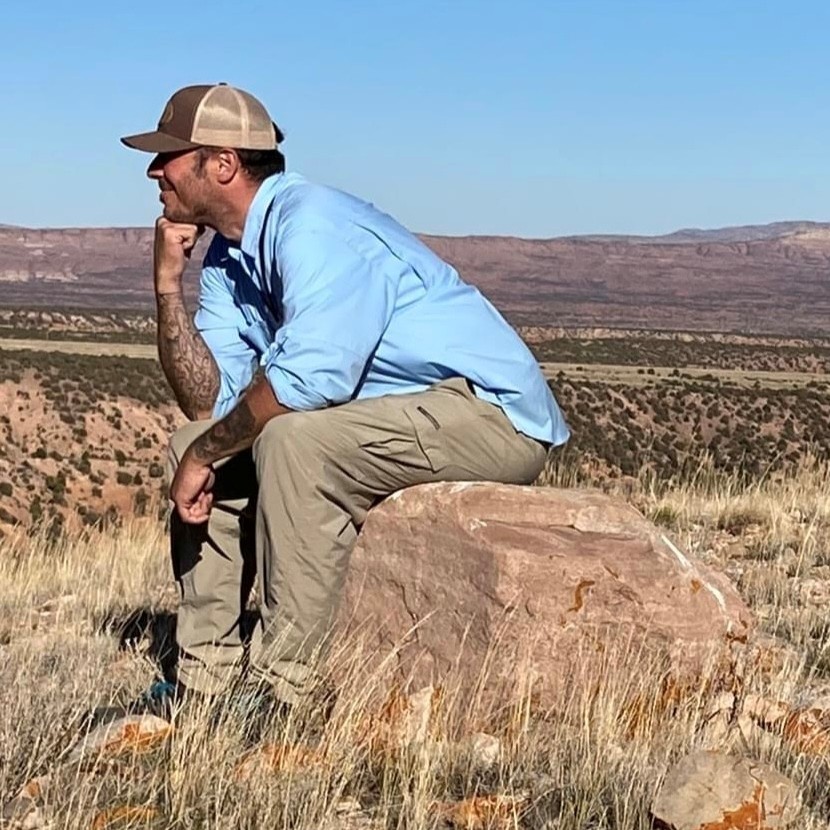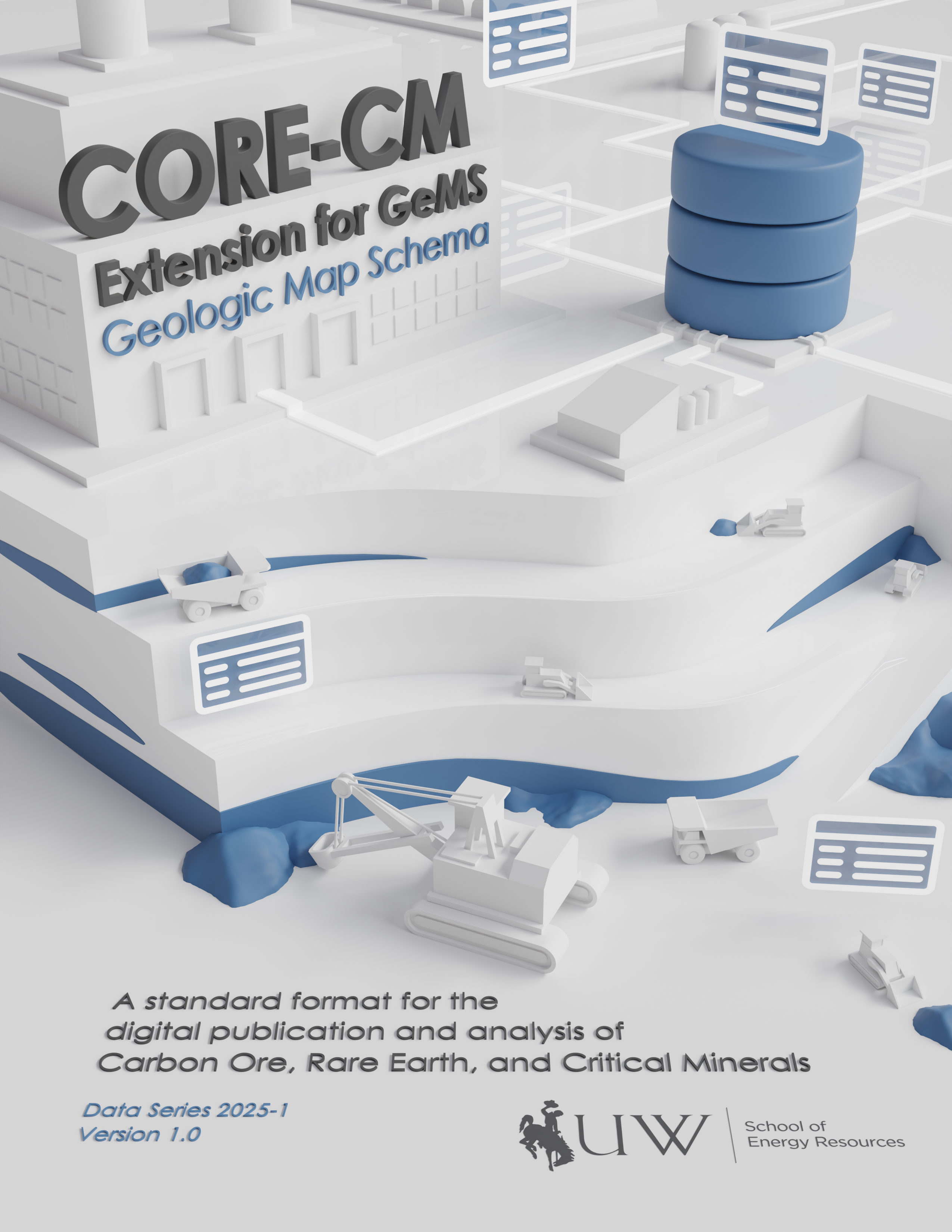~Research~
Field Geology — Unmanned Aerial Systems — Hyperspectral Imaging

PhD DISSERTATION
"USING AIRBORNE HYPERSPECTRAL IMAGING TO CHARACTERIZE, DISCRIMINATE, AND MAP TERTIARY GEOLOGY ALONG THE NORTHERN FLANK OF THE EASTERN UINTA MOUNTAINS, WYOMING-UTAH-COLORADO"Committee: Dr. Brandon McElroy (University of Wyoming); Dr. Joe Biasi (University of Wyoming); Dr. Tyler Brown (University of Wyoming); Dr. Austin Madson (University of Wyoming); Dr. Gregg Swayze (U.S. Geological Survey)
Geologic mapping, sometimes referred to as lithological mapping, is a tremendously interpretive scientific process that aims to reveal the composition and structure of earth's geological materials both at the surface and subsurface. The Tertiary geology along the northern flank of the eastern Uinta Mountains has remained unresolved despite 150 years of geologic mapping. There is great discordance about the stratigraphic relationships of the Fort Union, Wasatch, and Green River formations that make up the conformable succession of sedimentary rock in the areas surrounding Little Mountain in the greater Green River Basin of southwestern Wyoming.
Now, with further advancements in remote sensing, unmanned aerial systems, and algorithms that benefit from AI-driven analysis, our methods to map geology are radically evolving. Hyperspectral imaging (HSI) is a relatively new generation of remote sensing that acquires and analyzes reflected light in the Visual Near Infrared and Infrared wavelength regions of the electromagnetic spectrum. The refined spectral resolution of HSI can provide direct identification and analysis of surface materials. It has become increasingly popular in economic and environmental geology because of its ability to detect unique spectral signatures of substances otherwise visually indistinguishable. While most geology related HSI studies have focused on the classification and detection of minerals and/or rocks, few studies have focused on the classification and detection of sequences of rocks that make up a particular geological unit. The purpose and scope of this study is to determine whether airborne HSI can be used to characterize and discriminate similar but distinct members of a geologic formation and assist in mapping efforts where traditional methods have fallen short.

MS CAPSTONE (2025)
"DEVELOPMENT OF THE CORE-CM EXTENSION FOR GEMS (GEOLOGIC MAP SCHEMA)—A STANDARD FORMAT FOR THE DIGITAL PUBLICATION AND ANALYSIS OF CARBON ORE, RARE EARTH, AND CRITICAL MINERALS"The 3D Visualization Center in association with the Center for Economic Geology and Research at the University of Wyoming, School of Energy Resources (SER) has developed a relational database schema (standard format) for the digital publication and analysis of CORE-CM datasets. The design and development of this database schema (referred to as the CORE-CM extension) builds upon an existing schema developed by the U.S. Geological Survey (USGS) for geologic mapping referred to as the Geologic Map Schema (GeMS). GeMS provides for the encoding in digital form of the content contained in individual geologic maps published by the USGS and by state geological surveys. The CORE-CM extension provides for the encoding of the content derived from the CORE-CM initiative in a compatible format allowing for an enriched analysis. The CORE-CM extension is the foundation to build a geoscientific and geospatial framework to develop surface and subsurface modeling strategies for complex data analysis. The DOE, CORE-CM Technology Innovation Centers, and end-users of these datasets will all benefit from a standard database design for the digital representation and repository of CORE-CM data.

MS THESIS (2017)
"USING AMS TO HELP INTERPRET GLACIOGENIC DEPOSITS OF THE LATE PALEOZOIC ICE AGE IN THE PARANÁ BASIN, BRAZIL"Advisor(s): Dr. John Isbell (UW-Milwaukee); Dr. Julie Bowles (UW-Milwaukee); Dr. Fernando Vesely (Universidade Federal do Paraná)
There are many paleoenvironmental aspects of the Late Paleozoic Ice Age (LPIA) that are still unknown, including whether or not Gondwana was covered by one large ice sheet or if multiple smaller ice caps were spread across the supercontinent. In general, the occurrence of diamictites within the Gondwana succession has been traditionally used to indicate the occurrence of subglacial deposition despite the potential occurrence of other depositional modes. The ability to better differentiate between subglacial from glacial marine processes (e.g., subaqueous resedimented gravity flows, and rainout resulting from ice rafting) in addition to determining glacier flow or mass transport directions, will allow scientists to more accurately reconstruct and interpret diamictite deposits of the LPIA. One area of interest in Gondwana where these types of deposits are known to occur is in the Paraná Basin, Brazil. In sedimentary fabrics, anisotropy of magnetic susceptibility (AMS) has been used to determine the preferred orientation of the constituent grains to differentiate between modes of deposition (suspension, current, mass transport, lodgment), and to determine paleocurrent orientations. My research aim was to better understand if AMS can be used to delineate glaciogenic deposits of the LPIA
PUBLICATIONS:
Vesely, F.F., Rodrigues., M.C.N.L., da Rosa, E.L.M., Amato, J.A, Trzaskos, B., Isbell, J.L., Fedorchuk, N.D., 2018, Emplacement of non-glacial mass-transport diamictite within higher frequency glacial cycles during the Late Paleozoic icehouse: Geology
Amato, J. A., 2017, Using AMS to Help Interpret Glaciogenic Deposits of the Late Paleozoic Ice Age in the Paraná Basin, Brazil [10619377 M.S.]: The University of Wisconsin - Milwaukee, 161 p.
ABSTRACTS:
Amato, J., 2022, Best practices for creating clean GeoTIFF map products exported from ArcMap layout using GDAL utilities: Abstracts with Programs - Geological Society of America, v. 54, no. 5.
Amato, J., Al-Chokhachy, R., Hostetler, S., and Anonymous, 2016, Understanding variability of stream temperature to potential climatic drivers in headwater ecosystems; a need for salmonid conservation: AGU Virtual Poster Showcase, v. 5.
Amato, J., Hooyer, T., McCracken, R., Iverson, N., Schomacker, A., and Anonymous, 2014, Patterns of glacier sliding on drumlin surfaces, Mulajokull, Iceland: Abstracts with Programs - Geological Society of America, v. 46, no. 4, p. 9.
RESEARCH GRANTS:
 2016: University of Minnesota Institue of Rock Magnitism US Student Fellows
2016: University of Minnesota Institue of Rock Magnitism US Student Fellows
2016: Center for Latin American & Caribbean Studies Tinker Research Grant
2016: Center for Latin American & Caribbean Studies Travel Grant
2016: Society for Sedimentary Geology Student Assistance Research Grant
2016: Wisconsin Geological Society Research Grant
2014: UW-Milwaukee Dr. Robert E. Gernant Summer Field Work Scholarship
2013: Geological Society of America ‘On to the Future’ Travel Grant
2013: UW-Milwaukee Stipend for Undergraduate Research Fellows Award

USGS/NAGT COOPERATIVE FIELD TRAINING PROGRAM
Northern Rocky Mountain Science CenterBozeman, Montana: June - August 2016
Supervisor(s): Dr. Robert Al-Chokhachy, Dr. Adam Sepulveda
Established in 1965, the USGS/NAGT Cooperative Summer Field Training Program is one of the longest continuing science internship programs in the country, with many participants proceeding on to distinguished careers with the USGS, with academia, and with industry. Because of James' exemplary performance at field camp, he was nominated by his field camp director to participate in the program.
In 2016, James was selected to assist Dr. Robert Al-Chokhachy and Dr. Adam Sepulveda from the Northern Rocky Mountain Science Center on their ecology research projects in the Greater Yellowstone area. The projects entailed sampling for fish and amphibian distributions, in addition to deploying instrumentation to collect stream discharge and temperature information. The summer internship was a valuable experience for James, allowing him to gain a better understanding of what it's like conducting research for a federal agency, and the opportunity to develop a broader perspective for the field of biology.

RESEARCH ASSISTANT - ICELAND
UW-Milwaukee - Department of GeosciencesIceland: July - August 2013
Advisor(s): Dr. Thomas Hooyer, Dr. Neal Iverson
In 2013, James participated in two Iceland-based research projects as a student worker. He assisted Dr. Neal Iverson (Iowa State University) and Dr. Thomas Hooyer (UW-Milwaukee) collecting AMS samples for their drumlin formation research project at Múlajökull; an outlet glacier located in the Central Highlands. After, James assisted Bill Jacobson, a Ph.D. student at UW-Milwaukee, in collecting cores for his basal-ice research project at Flàajökull; an outlet glacier located in the Southeast. Participating in these projects was a valuable experience for James, allowing him to develop his skills of collecting data in the field and analyzing it in the lab. James went on to conduct his own undergraduate research project, investigating the direction of ice flow on drumlin surfaces.